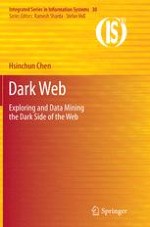Abstract
In this chapter, we review the computational research framework that is adopted by the Dark Web research. We first present the security research context, followed by description of a data mining framework for Intelligence and Security Informatics research.
The tragic events of September 11 and the following anthrax contamination of letters caused drastic effects on many aspects of society. Academics in the fields of natural sciences, computational science, information science, social sciences, engineering, medicine, and many others have been called upon to help enhance the government’s ability to fight terrorism and other crimes. Six critical mission areas have been identified where information technology can contribute, as suggested in the “National Strategy for Homeland Security” report, including: intelligence and warning, border and transportation security, domestic counterterrorism, protecting critical infrastructure, defending against catastrophic terrorism, and emergency preparedness and responses. Facing the critical missions of national security and various data and technical challenges, we believe there is a pressing need to develop the science of “Intelligence and Security Informatics” (ISI).
To address the data and technical challenges facing ISI, we present a research framework with a primary focus on KDD (Knowledge Discovery from Databases) technologies. The framework is discussed in the context of crime types and security implications. Selected data mining techniques, including information sharing and collaboration, association mining, classification and clustering, text mining, spatial and temporal mining, and criminal network analysis, are believed to be critical to criminal and intelligence analyses and investigations. In addition to the technical discussions, this chapter also discusses caveats for data mining and important civil liberties considerations.
